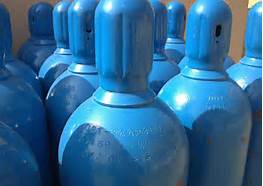Ultrasonic Examination (UE) can handle cylinders containing the following gas types:
 Argon (AR) Argon is colorless, odorless, tasteless, noncorrosive, nonflammable, and nontoxic. Argon is used primarily for its properties as an inert gas in applications such as arc welding, steelmaking, metal fabrication, heat treating, and electronics manufacturing. Argon provides the most effective cleaning action and offers welders excellent control of the welding arc and puddle.
Argon (AR) Argon is colorless, odorless, tasteless, noncorrosive, nonflammable, and nontoxic. Argon is used primarily for its properties as an inert gas in applications such as arc welding, steelmaking, metal fabrication, heat treating, and electronics manufacturing. Argon provides the most effective cleaning action and offers welders excellent control of the welding arc and puddle.
Carbon Dioxide (CO2) Carbon dioxide is anonflammable, colorless, odorless gas. Although not truly an inert gas, carbon dioxide is nonreactive with many materials and is often used for inerting purposes. It is also used as a shielding gas in the arc welding process due to its high heat conductivity and its ability to oxidize ferrous metals. Mixtures of carbon dioxide are often recommended to increase penetration of the weld. It is also the source of bubbles in soft drinks and other carbonated beverages. It is used in certain types of fire extinguishers that rely on its inert properties, density, and low temperature when released from high-pressure storage. In addition to its inert properties, carbon dioxide, as dry ice, is used to freeze a variety of foods.
Helium (HE) Helium is a colorless, odorless, tasteless inert gas. It is widely used in the arc welding process. Pure helium is excellent to use when the highest possible heat input is needed. Its low specific gravity and nonflammability allow its use in lighter-than-air applications, such as the filling of balloons. Mixtures of helium and oxygen are used as a breathing gas for deep-sea diving. Liquid helium is used in superconducting magnetic applications, including magenetic resonance imaging (MRI).
Hydrogen (H2) Hydrogen is a flammable, colorless, odorless, compressed gas at high pressure. It is mised with air to form the fuel gas for FID gas chromotography (using zero grade) and is sometimes a carrier gas. It is used int eh manufacture of silicon wafers and computer chips. Other uses are annealing and heat treating of metals. In the welding process, hydrogen provides high heat conductivity and reducing properties that makes it a valuable shielding gas for stainless steel. Mixtures of hydrogen are often recommended to increase compatibility with certain materials.
Nitrogen (N2) Nitrogen is colorless, odorless, tasteless and is nonreactive with many materials. Nitrogen is used for intering in electrical systems and chemical manufacturing. It is also used in cryogenic grinding of plastics, food freezing, and packaging.
Oxygen (O2) The principle uses of oxygen stem from its strong oxidizing and life-sustaining properties. It is used in medicine for therapeutic purposes and in the metals industry for steel making, metal-cutting applications, welding, hardening, scarfing, cleaning, and dehydrating. Oxygen is also used in teh production of a wide variety of fuels and chemicals.